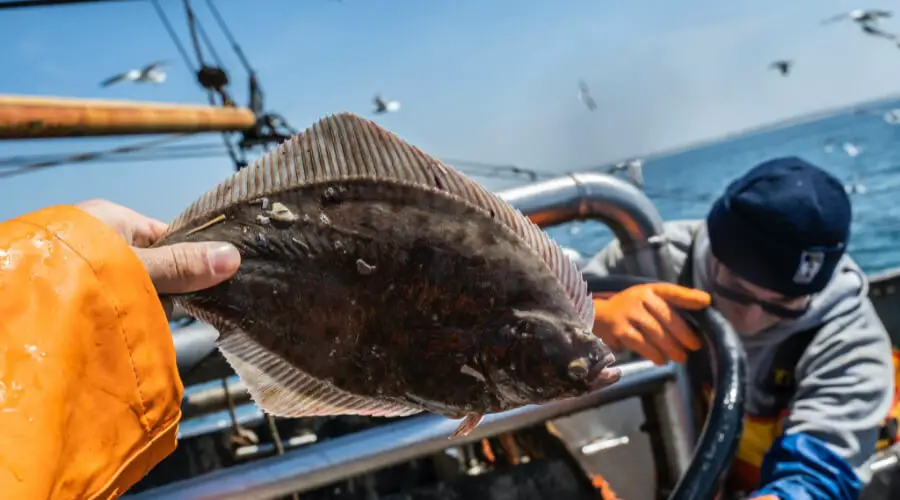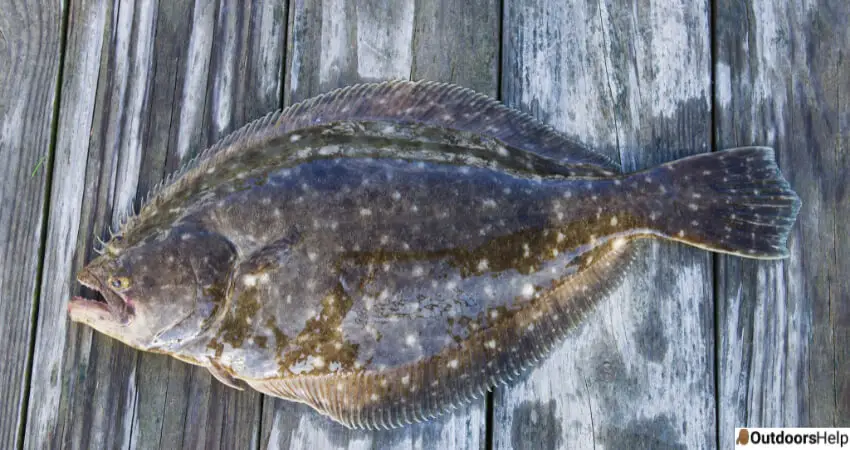Due to the massive variety of fish in the oceans, fishermen are always interested in what they will catch. Flukes and flounders are both categories of flatfish. They look similar at a glance but worry not because this article focuses on helping you to distinguish them. As an angler, are you conversant enough to tell their variances? Please stick around as we provide you all the facts and information and their diverse characteristics, habitats, and factual information.
Inhabiting the North Atlantic Ocean, the difference between the two is in the eyes. Flounders’ eyes are on the right while flukes’ are on the left side of their bodies.
They lay on either the right or left side during their larval stage, swimming upright when they start life. The eye facing the bottom drifts and then faces upwards. Some flatfish are left-sided up, meaning their right eye drifted to the left side, while others are right-sided up, meaning their left eye migrated to the right side. Making them blend well on the ocean bottoms, the top side of flatfish is mottled and dark. They can surprise the unsuspected prey as they are bottom dwellers, making them very effective. Let’s first define what they are before getting to their differences.
Found in the Atlantic Ocean off the East Coast of Canada and the United States of America, fluke is a marine flatfish. In Cape Cod, it is rimmed with long dorsal and anal fins with a flattened wide body. It has a large mouth full of more developed teeth on the right side of the jaw. In length, they can grow up to 23 inches and about 5 pounds in weight. Their common places are estuaries, canals, harbors, shorelines, and creeks in sandy and muddy bottoms. They move offshore in deeper and cooler water during winter and prefer the shallows during summer. Spawning occurs when they move offshore, and they feed on hake, silversides, crabs, other flounder, shrimp, and weakfish.
With a color range of reddish-brown to dark brown, flounder is a flatfish with a flat oval body. Some may have small black spots and rarely grow more than one foot in length, developing to about one or one and a half pounds. They migrate and spawn in the winter, summer, and spring to cooler parts of the estuaries, where adults move in the fall before the spawning. Snails, marine worms, small crustaceans, shelled invertebrates, and clams are what their diet is made of.
What Is The Relationship Between Fluke And Flounder?

Before we get to the distinguishing factors between fluke and flounder, it is important to understand the relationship between the two. Generally, the right-side-up flounders are called flounders, while the left-side-up flounders are flukes. Flounders or right-side fish are also called Winter Flounder, while flukes are also called Summer Flounder. A large grouping of loosely related fish is flounder, while fluke is just a type of flounder.
There are five species out of the 500 plus flatfishes, also called flounder. Four of the five flounder species are found in the Atlantic and are namely:
1. Winter flounder (left-side-up flukes)
2. Summer flounder
3. European flounder
4. Southern flounder
The fifth is Japanese flounder and is found in the Pacific Ocean. The main point to note is that not all flounders are flukes, but all flukes are flounders. Otherwise, all flounder is delicious.
Like other fish, they hatch from tiny eggs and start life as larvae that feed on plankton. They settle to the bottom and start changing after a month or two and are about a half-inch long at this stage. Until their bodies flatten out and they start swimming on their sides, their whole skeleton, nerves, and muscles shift around while the eyes also change. To blend into their surroundings, their skin finally begins changing in two to three weeks.
Differences Between Fluke And Flounder:
Showing up along the Gulf of Mexico and the Atlantic, the flounder, is one of favorite America’s inshore fish. They’re more than one species and are delicious to eat as well as fun to catch. Distinguishing which one you’ve hooked is as difficult as telling between south and north, or summer and winter. As large predatory species of flatfish that live in the North Atlantic, fluke and Winter Flounder live in the same place, which is why people get mixed up. There are several ways to luckily tell them apart and avoid confusion, as the following table unveils;
| Summer Flounder (fluke): | Winter Flounder: |
| Also known as fluke or Northern Flounder. | Also known as Blackback flounder. |
| When you hold it up, the head faces left hence, left-facing. | When you hold it up, the head is on the right hence, right-facing. |
| With cream or whitish spots, they are light brown. | Its appearance is darker than Summer flounders. |
| Lives from North Carolina to Maine. | Found in Canada from Maryland to Labrador. |
| Near the tail and on the back, it has three-ringed, eye-like spots. | Lack any spots or patches on the body. |
| Have well-developed, visible teeth with a big mouth. | Have no visible teeth and a small mouth. |
| During the warm season, they are in abundance. | During the winter season, they are in plenty. |
| Have an average lifespan of 20 years. | 12-14 years is their average lifecycle. |
| Their meat is firm and smooth, excellent for preparing sashimi and sushi. | Their meat is rough and tender, suitable for deep frying and braising. |
Fun Facts About Fluke And Flounder:
On the head, flatfish are born with an eye on each side. Towards the other side of the head and the other eye, one eye drifts or migrates as they grow. This is a unique feature of flatfishes in their transformation. Such an eye position helps target their prey, as these types of fish lie low on their side at the bottom of the oceans. With a slight difference, both fluke and flounder share these incomparable abilities.
1. Large flounder and fluke weighing at least 8-10 pounds are sometimes referred to as snow-shoes or doormats because they are flat.
2. They are aptly named in that summer flounder or fluke only come into the bay to be caught in the summer and winter off to the continental shelf, while winter flounders stay through the winter until the spring only to come to the bay in the fall.
3. Found in the Atlantic Ocean as bottom-dwelling fish.
4. Their faces are the surest way of telling them apart though the flounders can change color to match their surroundings.
Conclusion:
The easiest way to distinguish fluke from flounder is to examine their mouths as well the eye position. Fluke has a large mouth that extends further than the eyes, while flounder have small ones without the extension. Flounders are commonly caught in the winter, as the name winter flounder suggests, while flukes are commonly caught in warm months of the year.
After reading through this article to the end, I hope you now have answers to all your questions. Go out there and make the best out of all this and who knows, you might be lucky enough to enlighten the entire generation. Best of luck!

